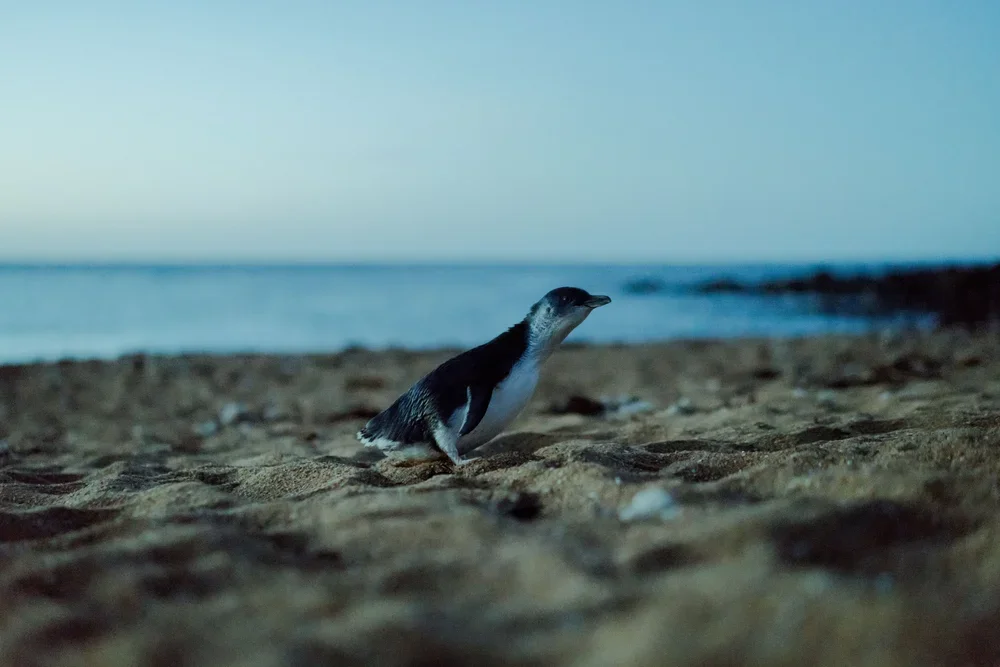A Year With Bicheno’s Penguins
How Tasmania’s Little Penguins Live, Breed, and Return Through the Seasons
Bicheno is one of the few places on Tasmania’s east coast where you can watch little penguins, also known as fairy penguins, return to their natural habitat every evening. These Tasmanian penguins form one of the region’s most cherished penguin colonies, a thriving colony of Little Penguins nestled into the dunes, granite boulders, and foreshore near Cooinda on the Beach.
Many locals have been incredibly generous in sharing their stories and photographs with us. Their memories, combined with conservation science and what we know from national parks and wildlife groups, give us a detailed picture of how these penguins live through the calendar year.
Spring
September to November
The breeding season begins
Spring marks the start of the annual breeding season.
This is when penguins breed. Males arrive first to prepare burrows, calling loudly through the dusk. Pairs reunite and line their nests with grass and seaweed, ready for eggs to be laid.
Bicheno’s penguins return earlier in the evening during spring and movement around the dunes is at its peak. If you have visited Phillip Island Nature Parks, you will notice the behaviour is familiar. It is the same only species of penguin that nests in Australia, but the setting here feels more intimate, quieter, and far more natural.
What you might see:
courtship displays
penguins carrying nesting material
increased calling around the dunes
Summer
December to February
Penguin chicks and busy nights
Summer is the height of activity along the coastline.
Parents travel to sea to feed, returning at night with bellies full of fish for their penguin chicks. Chicks grow rapidly, transitioning from fluffy grey down to their first waterproof feathers.
Many guests are surprised by how close Bicheno’s penguins live to the shoreline. The experience feels more authentic than what is often seen on mainland offshore islands and is especially magical on warm, still evenings.
What you might see:
adults arriving with food
chicks calling from burrows
fledging juveniles testing their new feathers
Autumn
March to May
The annual moult
Once chicks have fledged, Little Penguins begin their annual moult.
This is a critical period. Penguins replace every feather on their body and cannot swim for around two weeks. They remain on land, conserving energy inside their burrows.
You will still see penguins, but numbers are lower as each individual completes this transformation.
What you might see:
moulting adults sheltering near burrow entrances
clusters of shed feathers
shorter and quieter returns to shore
Winter
June to August
Life at sea
Winter is the calmest season on the coastline.
Little Penguins spend more time at sea rebuilding strength and travelling further offshore as food sources shift. While fewer penguins return to shore, Bicheno still offers sightings on still, clear nights.
This seasonal rhythm mirrors penguin behaviour seen at larger breeding colonies around Australia including the largest colony at Phillip Island, but with far fewer people and a much more natural feel.
What you might see:
small groups returning to maintain burrows
occasional calls carried on the wind
minimal disturbance along the dunes
What Locals Have Shared With Us
From conversations with long-time residents, several themes often emerge:
They have always been here.
Penguins have been nesting in Bicheno’s dunes and rocks for generations, long before the town became a holiday destination.
Everyone looks out for them.
Locals take pride in protecting penguins by reporting injuries, guiding visitors away from burrows, and supporting conservation measures.
You hear them before you see them.
Their calls are part of the soundscape of living on the east coast.
These shared memories offer a living portrait of a community and a wild colony growing side by side.
The Science: How to Watch Bicheno Penguins Safely
And Why It Matters
Little Penguins are small but incredibly sensitive animals. Their behaviour on land is shaped by survival instinct and human presence can easily influence their movements.
Scientists and conservation groups emphasise:
Stay 5–10 metres back
If you are too close, the penguin may hesitate, change direction, or delay feeding.
Use red light only
Bright white light can temporarily blind and confuse penguins. Red light preserves their night vision.
Keep paths clear
Never stand between the ocean and the burrows. Blocking routes causes penguins to retreat or wait offshore.
Stay low and quiet
A crouched human feels far less threatening than a standing one.
Never touch or follow
This may interrupt chick feeding and increase stress.
Understanding these principles helps minimise threats to Little Penguins including stress, navigation disruption, and exposure to introduced predators such as foxes, cats, and dogs.
A Unique Opportunity at Cooinda
Because of Cooinda’s direct beach access, guests often have a front row view of penguins returning home. It is something usually only experienced on a guided penguin tour or through Bicheno Penguin Tours.
It is a privilege to be so close to a wild penguin colony and we ask guests to enjoy the experience carefully.
Please:
use no bright white light
stay on the pathways
remain still and quiet
keep clear of burrow entrances and dune systems
follow the house rules provided in your welcome guide
These steps help ensure the penguins feel safe returning to an area where they have nested for decades.
Watching the Magic Happen
Whether it is a fluffy chick waiting for food in summer, the soft rustle of feathers during the autumn moult, or the sudden appearance of a small raft of penguins at dusk, watching Bicheno penguins through the seasons is one of the great treasures of the Tasmania east coast.
If you are fortunate enough to see them during your stay at Cooinda, we hope you feel what locals describe often. These birds are not just wildlife. They are part of the heartbeat of the coastline.
